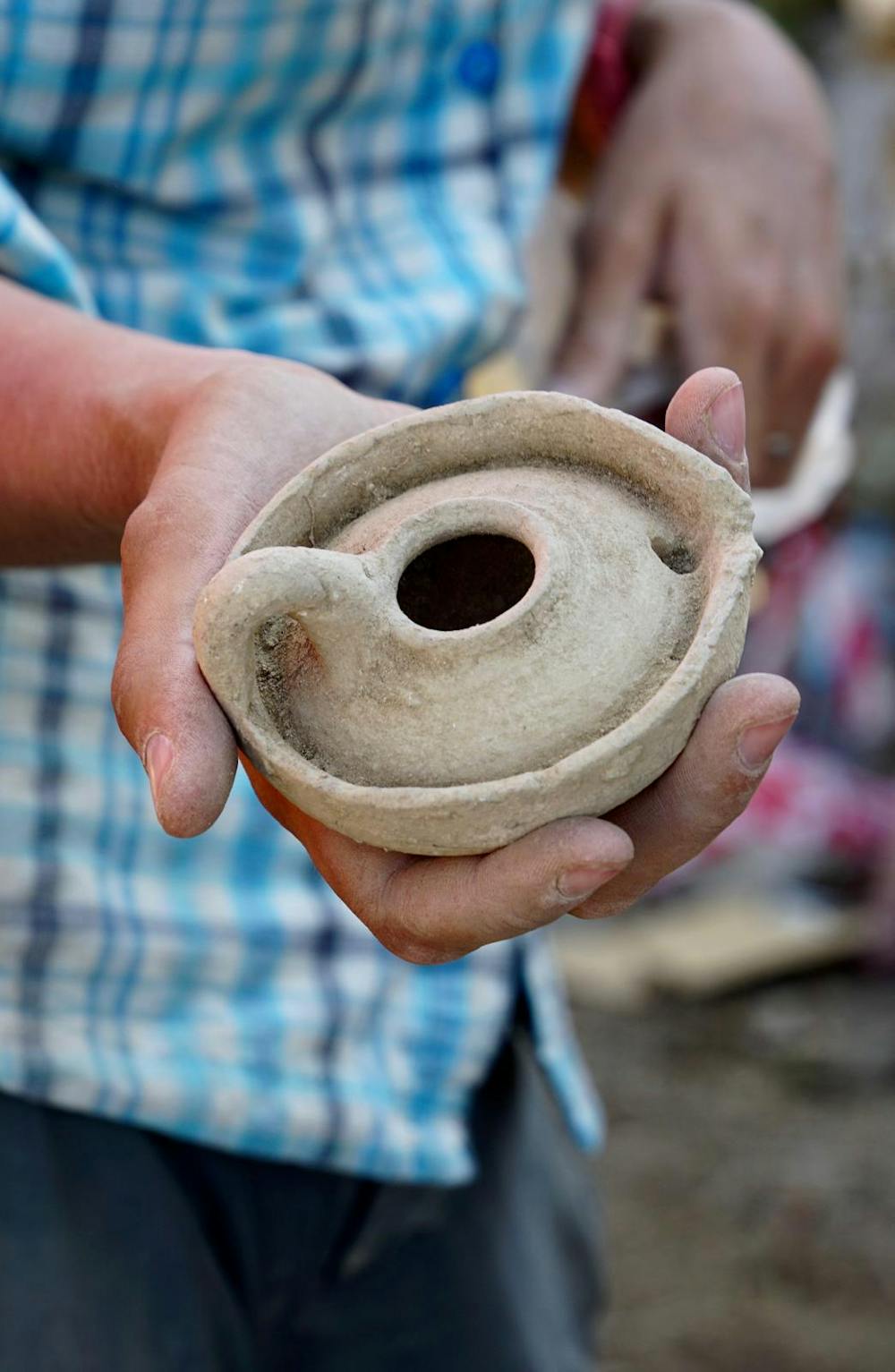Not many people can say they spent their summer doing what Liza Davis GS called “toe retrieval duty.”
Davis, a PhD candidate at Brown, worked as a trench supervisor this summer for an ongoing excavation of Antiochia ad Cragum, a Roman city located in modern-day Turkey, she explained to a room filled with professors, students and affiliates of the Joukowsky Institute for Archaeology and the Ancient World.
On Friday, Brown archeologists, who traveled to conduct research in South America, Europe and Asia, took turns presenting their findings.
Davis’s project this summer excavated new areas in a site which had previously identified baths, streets with shops and industrial installations. Her goals were to update the plan of a structure called the East Church, identify its phases of construction and determine if it was, in fact, a church.

Floor surface in the East Church.
Courtesy of Liza Davis
“An exciting moment was the accidental discovery of a cistern in the north (part) of the building that was repurposed as a tomb for two individuals,” Davis said in her presentation.
The hole was discovered while removing boulders — a “very Indiana Jones moment,” she said.
“I had great fun going in there after (we) excavated the individuals,” she said, showing a photo of her smiling up from the hole. “I was on toe retrieval duty — so, you know, looking for toe bones and pieces of pottery that were in there.”
Other findings included a cache of lamps and a large inscription — 68 lines of Greek dating to the year 113 B.C.E. Davis will use this experience to inform her dissertation, which looks at early Christianity in the region, she said.
“So all in all, it was a great summer,” Davis concluded.

Liza Davis excavates a cistern-turned-tomb in the narthex of the East Church at Antiochia ad Cragum.
Courtesy of Liza Davis
The annual event allows colleagues and students to come back together and hear about each others’ projects, said Andrew Scherer, director of the Joukowsky Institute. Since much of the researchers’ work concerns “archaeology abroad,” affiliates are often away from campus for a long time.
“It's the rhythm of how archaeology happens,” Scherer told The Herald. Fieldwork takes place in the summer, ranging from excavating sites and dating pottery to archival work at museums to remote sensing using ground-penetrating radar. Back on campus, researchers process their data, identifying patterns or writing reports. That work then informs continuing or new fieldwork the following summer.
Postdoctoral Research Associate Zachary Silvia spent his summer in the Bukhara Oasis in western Uzbekistan. Since 2016, Silvia has been part of an effort to excavate a site called Bashtepa, an ancient fortification founded in the early third century B.C.E.
“If you can believe it, the surrounding landscape in antiquity was this vast agricultural area full of field systems and small farmhouses and all sorts of hydrological activities,” Silvia said, showing pictures of the arid modern-day landscape. Silvia has been working to survey the ancient agricultural landscape in a non-destructive way, determining which geophysical and remote-sensing methods will work best for the region — aerial thermography, for example, or ground-penetrating radar.
“We’re looking for buildings, production areas, field systems and hydrology,” Silvia said, adding that various methods revealed field systems dating to the Hellenistic period.

Drone photo of the East Church at the end of the field season.
Courtesy of Liza Davis
The most sensational find from the summer, however, is straight out of a storybook — or rather, a ninth-century history text describing the destruction of an early mosque in Bukhara City, at the same site as the current Po-i-Kalan mosque complex built in the 12th century. When Bukhara City was invaded, according to the history text, someone accidentally shot a flaming arrow in the wrong direction, destroying the early mosque, Silvia explained.
This was the basis for Silvia and his colleagues to conduct ground-penetrating radar around the mosque complex. In particular, they were focused on a marble plaza connecting buildings in the complex.
“In the complex between this madrasa here and the mosque, we see what is possibly an earlier minaret,” Silvia said. The history text describes the early minaret falling over, having been built too large. “We might have found it.”
For Gretel Rodriguez, an assistant professor of History of Art and Architecture, this summer was a chance to continue her ongoing research on Roman conquest-era sanctuaries dedicated to water deities.
But she was also able to revisit completed work, tying up one loose end in particular: Previously, Rodriguez had studied the Arch of Carpentras, a Roman triumphal arch from the first century CE located in modern-day France.
“This is a monument that I have been studying for many years, and I have never had a chance to come close to it. I’ve never gotten a permit,” Rodriguez said in her presentation, noting the arch is surrounded by a low wall. “I did not get a permit this year either. But I got really lucky because when I got there, there was a high school teacher with a group being shown in.”
“So I basically just went in with them,” Rodriguez said. “The students actually told the professor. Then she started screaming at me. And I literally begged her, I said ‘Please, let me take a look.’”
In the end, after ten years of not being allowed inside, Rodriguez was able to get up close to the structure and take pictures.
“I know that it might not look like much to you, but they are very dear to me,” she said.
Haley Sandlow is a contributing editor covering science and research. She is a junior from Chicago, Illinois studying English and French.





